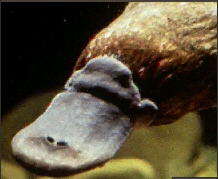
 Similarly, when I see a biological entity, I am transported in thought by the entire biological history—both ontogenic and phylogenic, but of course with an emphasis on the latter—of the creature. In this respect, every living thing is awesome or beautiful. But different phyla have different evolutionary histories; and so different kinds of animals will be beautiful in different ways (or perhaps to different degrees). A duckbilled platypus, for instance, inspires Awe in me due to its very being; but in spite of its Beauty as an end result of an awesome evolution—and disregarding its attractiveness to other duckbilled platypuses—few people would want to say that a duckbilled platypus is beautiful. An eagle or a lion perhaps; but a duckbilled platypus seems to be the epitome of ugliness. What lies at the bottom of this judgment, however, is the very nature of the particular beast in question. A lion or an eagle is truly beautiful because of its own evolutionary situation; but what needs to be emphasized here, what plays a significant part in this "evolutionary situation", is the fact that these animals are hunters whereas duckbills are foragers. Hunting-predators need a different kind of knowledge and understanding about their environments than do foraging-predators—animals like the duckbilled platypus. In particular, the set of the eyes to allow for true stereoscopic vision can be of great advantage for the hunter. And it cannot be denied that this facial characteristic plays an important role in the Beauty of lions and eagles. The platypus, on the other hand, uses its snout as a primary means of finding its food; and consequently it is this unflattering organ—unflattering as far as humans are concerned—that receives an unfair balance of evolutionary development and thus catches the human eye. Similarly, when I see a biological entity, I am transported in thought by the entire biological history—both ontogenic and phylogenic, but of course with an emphasis on the latter—of the creature. In this respect, every living thing is awesome or beautiful. But different phyla have different evolutionary histories; and so different kinds of animals will be beautiful in different ways (or perhaps to different degrees). A duckbilled platypus, for instance, inspires Awe in me due to its very being; but in spite of its Beauty as an end result of an awesome evolution—and disregarding its attractiveness to other duckbilled platypuses—few people would want to say that a duckbilled platypus is beautiful. An eagle or a lion perhaps; but a duckbilled platypus seems to be the epitome of ugliness. What lies at the bottom of this judgment, however, is the very nature of the particular beast in question. A lion or an eagle is truly beautiful because of its own evolutionary situation; but what needs to be emphasized here, what plays a significant part in this "evolutionary situation", is the fact that these animals are hunters whereas duckbills are foragers. Hunting-predators need a different kind of knowledge and understanding about their environments than do foraging-predators—animals like the duckbilled platypus. In particular, the set of the eyes to allow for true stereoscopic vision can be of great advantage for the hunter. And it cannot be denied that this facial characteristic plays an important role in the Beauty of lions and eagles. The platypus, on the other hand, uses its snout as a primary means of finding its food; and consequently it is this unflattering organ—unflattering as far as humans are concerned—that receives an unfair balance of evolutionary development and thus catches the human eye.
|

